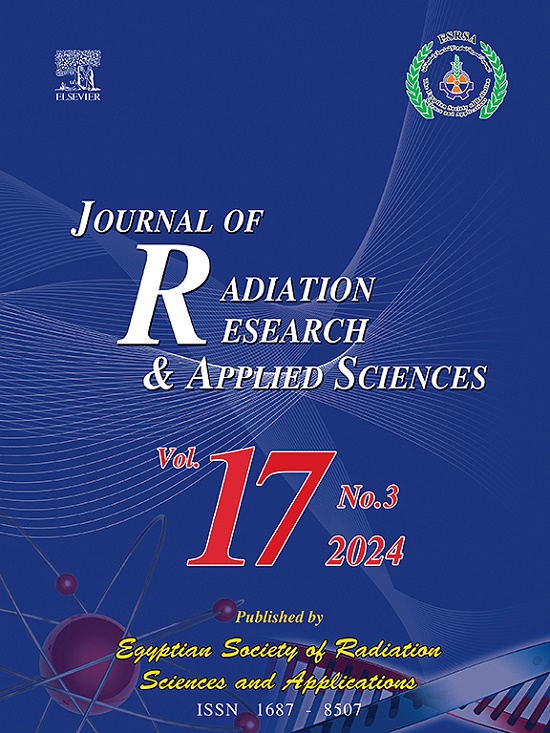Investigation of the clinical benefits of regular breath-holding training utilizing surface guided radiation therapy technology for patients with left breast cancer
IF 1.7
4区 综合性期刊
Q2 MULTIDISCIPLINARY SCIENCES
Journal of Radiation Research and Applied Sciences
Pub Date : 2025-03-18
DOI:10.1016/j.jrras.2025.101393
引用次数: 0
Abstract
Background
The deep inspiration breath-hold (DIBH) technique has indeed been widely applied in breast cancer radiotherapy, with numerous studies demonstrating its significant advantages in reducing radiation doses to the heart and lungs. However, previous research has primarily focused on the dosimetric benefits of the DIBH technique, with relatively little attention given to the stability and duration of breath-holding. This study aims to evaluate the practical benefits of regular breath-holding training in the DIBH workflow by quantitatively analyzing how such training reduces setup and treatment times and improves workflow efficiency.
Materials and methods
This single-center randomized, self-controlled clinical trial involved fifty patients diagnosed with left breast cancer. Twenty-five patients received regular breath-holding training throughout their treatment (trained group), while twenty-five control patients were provided only with basic instructions during their initial treatment session (untrained group). Data on breath-holding duration, radiotherapy setup time for the trained group, and overall treatment time for both groups were collected. Breath-holding stability was assessed by comparing Real Time Coach (RTC) from AlignRT at the setup stage, X-Ray Volume Imaging (XVI), and during treatment.
Results
In the training group, 22 patients (88%) completed regular breathing training, resulting in the collection of 363 sets of breathing training data. Regular training resulted in a gradual increase in breath-holding duration; specifically, setup time decreased from over 320 s during the first session to approximately 200 s by the fifth session. The trained group exhibited a significantly shorter treatment duration (233.85 ± 51.36 s) compared to the untrained group (323.71 ± 104.75 s; p < 0.05). RTC results at the setup stage, XVI, and during treatment showed no significant differences between groups (p > 0.05).
Conclusions
Regular breath-holding training enhances both breath-holding duration and patient cooperation while strengthening doctor-patient relationships and reducing both setup and treatment times. It is recommended to incorporate regular breathing training into the workflow of peer DIBH treatment and to implement three breath-holding sessions during the setup process for fine-tuning and validation, aiming to optimize breath-holding stability.
利用表面引导放射治疗技术对左乳腺癌患者进行定期屏气训练的临床疗效探讨
深吸气屏气(DIBH)技术确实在乳腺癌放疗中得到了广泛应用,大量研究表明其在减少对心脏和肺部的辐射剂量方面具有显着优势。然而,先前的研究主要集中在DIBH技术的剂量学益处上,相对较少关注屏气的稳定性和持续时间。本研究旨在通过定量分析这种训练如何减少设置和治疗时间并提高工作流程效率,评估定期屏气训练在DIBH工作流程中的实际效益。材料和方法本单中心随机、自我对照临床试验纳入50例诊断为左乳腺癌的患者。25名患者在整个治疗过程中接受定期屏气训练(训练组),而25名对照患者在初始治疗期间仅接受基本指导(未训练组)。收集训练组的屏气时间、放疗准备时间和两组的总治疗时间的数据。通过比较AlignRT在设置阶段、x射线体积成像(XVI)和治疗期间的实时教练(RTC)来评估屏气稳定性。结果训练组22例患者(88%)完成了常规呼吸训练,共收集了363组呼吸训练数据。定期训练导致屏气时间逐渐增加;具体来说,设置时间从第一次会话期间的320秒以上减少到第五次会话时的大约200秒。训练组的治疗时间(233.85±51.36 s)明显短于未训练组(323.71±104.75 s);p & lt;0.05)。RTC结果在设置阶段,十六,和治疗期间显示组间无显著差异(p >;0.05)。结论定期屏气训练可以延长屏气时间,提高患者配合度,加强医患关系,减少设置和治疗次数。建议在同行DIBH治疗的工作流程中加入定期的呼吸训练,并在设置过程中实施三次屏气,进行微调和验证,以优化屏气稳定性。
本文章由计算机程序翻译,如有差异,请以英文原文为准。
求助全文
约1分钟内获得全文
求助全文
来源期刊

Journal of Radiation Research and Applied Sciences
MULTIDISCIPLINARY SCIENCES-
自引率
5.90%
发文量
130
审稿时长
16 weeks
期刊介绍:
Journal of Radiation Research and Applied Sciences provides a high quality medium for the publication of substantial, original and scientific and technological papers on the development and applications of nuclear, radiation and isotopes in biology, medicine, drugs, biochemistry, microbiology, agriculture, entomology, food technology, chemistry, physics, solid states, engineering, environmental and applied sciences.
 求助内容:
求助内容: 应助结果提醒方式:
应助结果提醒方式:


